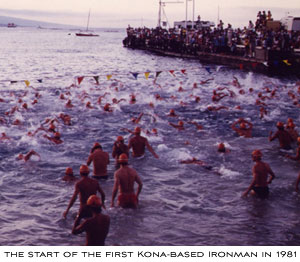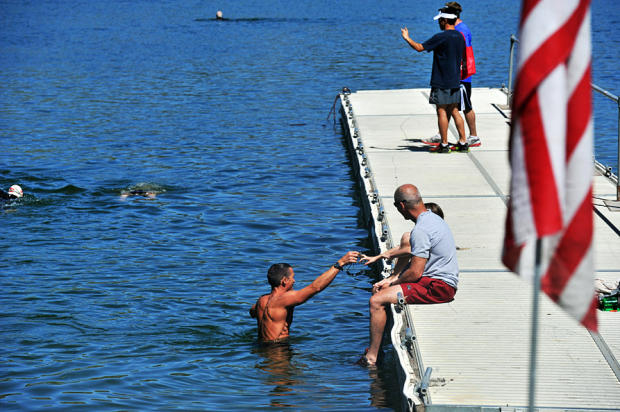Getting sponsors
Triathlon is a tough sell to a sponsor, on the face of it. The numbers aren't there. I mean, yes, it's nice to sponsor a 700-person triathlon. But if you're heading a company that needs visibility, you could choose to be title sponsor of a 700-person 5k/10k for a lot less money, right?
So how do you convince sponsors to come on board?
There are several things going on right underneath the surface that, if properly explained, will swing things back around in your favor.
First, there is the level of commitment a triathlete has to his sport. A 10k runner is, on average, only loosely glued to his event. His financial investment is light and, so is his equipment investment. He buys a pair running shoes and he's ready to go. Not so a triathlete.
So if you're a manufacturer or retailer of a Bulova watch, or Cadillac's SUV, aren't you more likely to sell a car to one of 700 people who can afford to race yachts, engage in an equestrian competition, or do a triathlon?
Triathletes are a polished demographic. They are not only high achievers in sport, but in life. I'm not sure if this is still the case, but at one time the single most prevalent occupation in triathlon was attorney (hey, lawyer jokes aside, they can afford to spend a lot of money). In America at least, triathlon is the sport of movers and shakers. That's valuable to sponsors. (For more specific information on triathlon's recent demographics—if you need them to prepare a written presentation—contact USA Triathlon. Also look at our somewhat dated State of the Sport feature for 2003.)
But how do you tap into that sponsor money, and how do you deliver value? This latter point is important, because you don't want to have to make this sale over and over again. If it's a good deal for your sponsor, they'll be happy and they'll stick around year after year.
My recommendation is, get creative. Make a company a deal it can't refuse. Let's use a regional bank as an example. Here is what the bank might do for the race:
* Pay $20,000 in consideration for title sponsorship.
* Devote a significant portion of its radio advertising toward a push for race registration starting 12 or 16 weeks out.
* Pay for, and host, point-of-purchase flyers at its teller windows.
* Insert flyers into paycheck envelopes prompting its employees to enter the race, or to volunteer at the race.
Why in the world would a bank want to make an investment like that? Frankly, this is not a difficult sell, if artfully presented, and when I'm done explaining maybe you can see why. Here's what the race will do for the bank:
* The bank gets title (or presenting) sponsor designation.
* It also gets rebate of $30 per entrant from all bank employees and dependants.
* And, a $15 rebate from every non-bank entrant.
* And, a $5 donation from every entry toward the bank's favorite charity.
First, there's an assumption that bank employees and dependants are able to receive some special consideration (like a discount) when entering, and that's easily accomplished through typing in a private code during registration. This allows an online registration engine like Active.com to identify how many bank-related registrations occur.
Now, let's work this out, from the point of view of the bank. Let's say that through your ambitious efforts, with the bank's robust help, you're able to land 1000 entrants: 650 non-bank-related, and 350 bank-related. The bank will make, through the entry-fee rebates, $20,000, that is, it's washed clean, self-liquidated, and it will have gotten it's financial investment back entirely. Heck, if you end up with 1400 entrants, the bank earns $10,000 through its title sponsorship. If you fall short of your goal, the bank still ends up with a lot of its money back, and you have a $20,000 cushion to start with.
The bank also has a very nice "human relations" program to which it can point. Every company likes to do this sort of thing, to show its support and affection for its own employees. You can print out our Beginner Training Program (with our prior permission, of course) and administer it to all bank employees, customers, and dependants who want to take part. Find yourself a willing, attractive, amicable and knowledgeable coach who can host semi-regular get-togethers of bank employees—Team in Training-style—with training clinics, open-water clinics, and so forth.
Almost every large corporation has a charity it embraces. You'll also raise, in our fictional example, $5000 for that charity, plus you'll offer ways to educate all competitors and race spectators as to the benefit of giving to that charity.
In other words, this is an opportunity for the bank to execute a variety of its goals in one fell swoop—engage in a robust human relations campaign; raise money for its chosen charity; increase its visibility in its community; and introduce itself to several hundred (and maybe a few thousand) of its A+ prospective new bank customers—and to do so cheaply.
What does your race get out of this, especially if its ends up being a self-liquidating sponsorship for the bank? How can it be good deal for you if no money is really changing hands, if the title sponsorship nets out zero?
* You got your $20,000 seed money up-front.
* The bank is getting you perhaps several hundred entrants via its own marketing to its own reservoir of tens of thousands of employees and customers.
* You'll have one big sponsor "in the bank"—so to speak—which will make it easier to recruit sub-title or associate sponsors.
* The bank is giving your race many of its radio (and perhaps newspaper) ad spots, further promoting race entries.
* You can leverage that bank's resources to get your other sponsors; i.e., if each branch of each bank has posters and POPs displayed with sub-title sponsors listed, that's additional exposure for these secondary sponsors.
* The bank's help in increasing the race's visibility will increase the event's media worth; you're more likely to have a bigger newspaper, radio and TV presence at your event.
* As you develop your relationship with the bank's key officers, ask them to throw their weight around. Do they advertise enough with a particular radio station to suggest that the station be at the race personally, increasing visibility for the race? If you can do this, and you know in advance that it is going to happen, this makes your other sponsorships easier to sell.
* You're still doing fine financially. Let's say your entry fee is $75. You're still netting $55 per entry, if you blend non-bank and bank entries in a 2:1 ratio. Charge what you need to in order to cover your rebates to the bank.
This is one of a great many creative ideas for getting a significant sponsor. Maybe your sponsor is a supermarket, and the money comes from sub-sponsors who are product companies granted end-aisle and other display promotions from the supermarket. In this case the supermarket gets off without paying you money, and its vendors are where your money comes from.
My understanding is that this is essentially how the Dannon Duathlon series used to work for many years. As each Dannon race came into town Dannon is able to convince its retailers to stock thousands of extra cases of Dannon Yogurt, and through a variety of cross-promotional avenues guess what? The extra yogurt actually does move off the shelf when a Dannon race comes to town! Dannon is a hero to its customer (the supermarket). The race has enough sponsorship to do well. Everybody wins.
The nice thing about this kind of sponsorship is that you get a lot of useful "in-kind" consideration, that is, your finish line buffet is stocked with, among other things, a lot of Dannon yogurt that you wouldn't otherwise have to buy.
What's my point? Think outside the box. Think in other terms besides money-for-a-finish-line-banner. If you think lazily, you'll never get a sponsor to give you any money in any decent amount. If you're creative and you use the specific value that triathlon delivers—namely, that it's a great sport and a lot of people aspire to do one!—you'll be surprised at how successful your sponsorships can be for you.
My organization was able to raise $700,000 in sponsorships for a national series of triathlons in only the second year of the series (back in the 90s). But it wasn't easy. It involved a lot of cross-promotions and leverages. Three-month free memberships to a national health club chain inserted into tens of thousands of running shoe boxes. Things like that. Sometimes the race isn't really the big enchilada in these deals, it's just the glue that binds all these other cross-promotional efforts between the really big players. This is how the successful deals are done! (They aren't usually straightforward.)
My advice? Don't think in terms of selling a triathlon. Put yourself in the place of a human relations manager of a medium-to-large company. Think in terms of helping a company sell its product. Then slip your race in there somewhere and construct a creative deal that helps everyone involved meet their goals.







Start the discussion at forum.slowtwitch.com